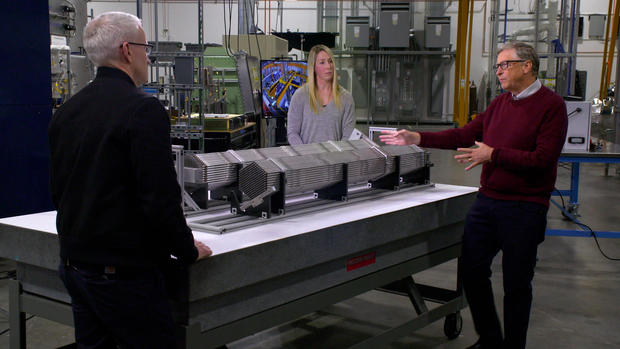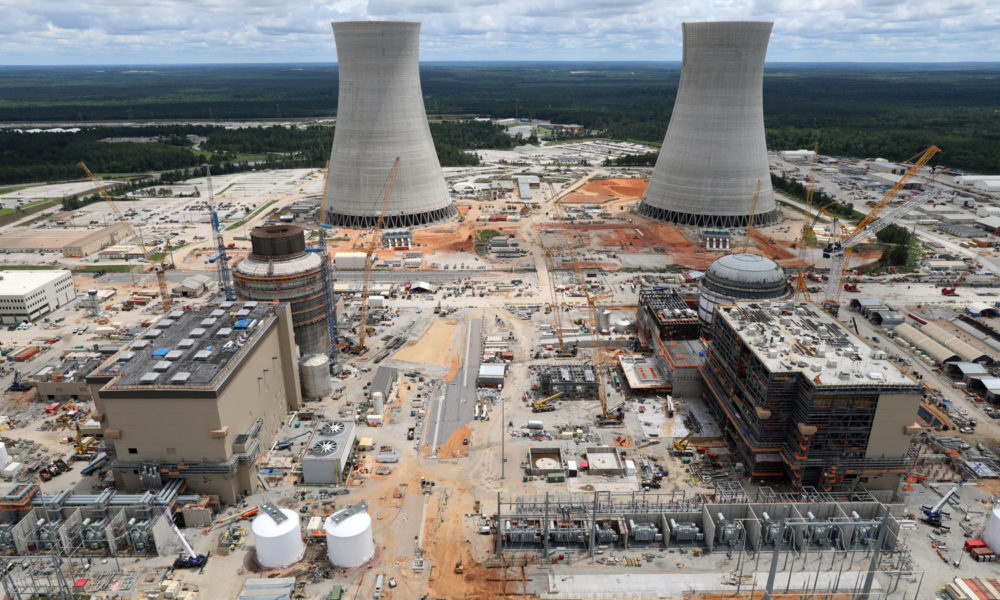Nuclear power proponents have long been prone to wishful thinking. Back in 1954, Atomic Energy Commission Chairman Lewis Strauss famously predicted that nuclear-generated electricity would ultimately become “too cheap to meter.” Today, nuclear power is among the most expensive forms of electricity.
Strauss’s successor at the commission, Nobel laureate Glenn Seaborg, projected in 1971 that nuclear power would produce nearly all the world’s electricity by 2000. Today, nuclear energy’s share of worldwide electricity is only 10 percent. In the United States, it produces about 20 percent, and about a third of the country’s fleet of aging reactors is struggling to compete with cheaper electricity sources.
Even so, there is growing interest in expanding the role of nuclear power to address climate change. As a low-carbon electricity source, it has obvious advantages over natural gas and coal. But besides being extremely expensive to build, conventional reactors—called light-water reactors because they use ordinary water to cool their radioactive cores—are beset by serious safety and security issues and generate radioactive waste that has to be sequestered for hundreds of thousands of years.
Enter “advanced” reactor designs
Undaunted, some nuclear energy developers are now promoting what they call “advanced” reactor designs as a solution. Unlike light-water reactors, these non-light-water designs rely on materials other than water for cooling, including liquid sodium, helium and molten salt. Some developers contend these reactors, which are still in the concept stage, will solve all the problems that plague light-water reactors and be ready for prime time by the end of the decade.
The siren song of a cheap, safe and secure nuclear reactor in the offing has attracted the attention of Biden administration officials and some key members of Congress, who are looking for any and all ways to curb carbon emissions. But are so-called advanced reactors merely the latest version of nuclear wishful thinking? A comprehensive Union of Concerned Scientists (UCS) analysis of non-light-water reactor concepts in development suggests they are. Published in mid-March, the 140-page report found that these designs are no better—and in some respects significantly worse—than the light-water reactors in operation today.
Safety, security and sustainability
The report, “Advanced” Isn’t Always Better, assesses the pros and cons of three main types of non-light-water reactors: sodium-cooled fast reactors, high-temperature gas-cooled reactors and molten salt–fueled reactors. It rates each type on three broad criteria: safety; nuclear proliferation and terrorism risks; and sustainability, which refers to how efficiently they use uranium and how much long-lived nuclear waste they generate.
“If nuclear power is to play a larger role in addressing climate change, it is essential for new reactor designs to be safer, more secure, and pose comparable or—better yet—lower risks of nuclear proliferation and nuclear terrorism than the existing reactor fleet,” says report author Dr. Edwin Lyman, a physicist and director of nuclear power safety at UCS. “Despite the hype surrounding them, none of the non-light-water reactors we reviewed meet all those requirements.”
At the end of May, the US nuclear power fleet was comprised of 93 light-water reactors, 11 fewer than in 2003. The industry’s decline was due to a number of factors, especially aging infrastructure and the inability to compete against natural gas as well as wind and solar, which are now the cheapest source of electricity in most countries around the world.
To try to stem its decline, the US nuclear industry promoted a “renaissance” in the early 2000s, and in 2005, Congress provided nearly $20 billion in federal loan guarantees for new nuclear reactors. The industry’s multimillion-dollar PR campaign has resulted in only two new Westinghouse AP1000 light-water reactors (in the foreground of the photo above), which are still under construction in Georgia with a price tag of $14 billion each—double their estimated cost—and taking more than twice their estimated completion time.
Given this struggle to build even standard-sized (1,000-megawatt) light-water reactors, the industry has turned to two other strategies to try to secure a bigger market share: small, modular light-water reactors, which—because of economies of scale—would produce even more expensive electricity than conventional reactors; and non-light-water reactors, which are largely based on unproven concepts from more than 50 years ago.
Outsized claims
The UCS report takes a close look at unsubstantiated claims developers have been making about these non-light-water designs. With little hard evidence, many developers have maintained they will be cheaper, safer and more secure than currently operating reactors; will burn uranium fuel more efficiently, produce less radioactive waste, and reduce the risk of nuclear proliferation; and could be commercialized relatively soon.
One of these reactors, TerraPower’s 345-megawatt, sodium-cooled Natrium fast reactor, received considerable media attention earlier this year when TerraPower founder Bill Gates touted it during interviews about his new book, How to Avoid a Climate Disaster. In mid-February, Gates told CBS’s 60 Minutes that the Natrium reactor will produce less nuclear waste and be safer and cheaper than a conventional light-water reactor.

In fact, according to the UCS report, sodium-cooled fast reactors would likely be less uranium-efficient and would not reduce the amount of waste that requires long-term isolation. They also could experience safety problems that are not an issue for light-water reactors. Sodium coolant, for example, can burn when exposed to air or water, and the Natrium’s design could experience uncontrollable power increases that result in rapid core melting.
“When it comes to safety and security, sodium-cooled fast reactors and molten salt–fueled reactors are significantly worse than conventional light-water reactors,” says Lyman. “High-temperature gas-cooled reactors may have the potential to be safer, but that remains unproven, and problems have come up during recent fuel safety tests.”
Fast reactors have another major drawback. “Historically,” the report points out, “fast reactors have required plutonium or [highly enriched uranium]-based fuels, both of which could be readily used in nuclear weapons and therefore entail unacceptable risks of nuclear proliferation and nuclear terrorism.” Some fast reactors, including the Natrium, will initially use a lower-enriched uranium fuel, called high-assay low-enriched uranium, which poses a lower proliferation risk than highly enriched uranium, but it is more attractive to terrorists seeking nuclear weapons than the much lower-enriched fuel that current light-water reactors use.
Unrealistic timetable
Timing is also an issue. Some developers claim they can demonstrate, license and deploy their non-light-water reactors on a commercial scale within as little as six years, enabling them to address the climate crisis in the near term. Last fall, for example, the Department of Energy (DOE) gave TerraPower and X-Energy, developer of a high-temperature gas-cooled “pebble-bed” reactor, $80 million each to begin operating first-of-a-kind commercial units by 2027. In June, TerraPower announced that it would site its demonstration reactor in Wyoming. X-Energy, meanwhile, will most likely locate its demonstration plant at the Columbia Generating Station in Washington State.
From concept to a commercial unit in six years? The new Westinghouse AP1000 light-water reactor provides a cautionary tale. It took more than 30 years of research, development and construction before the first one was built in China and began to generate power in 2018. According to the UCS report, if federal regulators require the necessary safety demonstrations, it could take at least 20 years—and billions of dollars in additional costs—to commercialize non-light-water reactors, their associated fuel cycle facilities, and other related infrastructure.
“One of the new reactor designs being considered, the ‘breed-and-burn’ reactor, has the most potential because it doesn’t require reprocessing—or recycling—spent nuclear fuel, which poses unacceptable proliferation risks,” says Lyman. “But the concept is still saddled with considerable technical obstacles and safety hazards due to the fact that fuel would remain in the reactor longer than in a light-water reactor, allowing fission gases and pressure to build. That may be the reason why TerraPower suspended work on a breed-and-burn reactor design in favor of the Natrium.”
Next steps
The Nuclear Regulatory Commission (NRC) may have to adapt some regulations when licensing reactor technologies that differ significantly in design from the current fleet, but Lyman says that should not mean loosening standards that protect public health and safety. He finds no justification for the claim that “advanced” reactors will be so much safer and more secure that the NRC can exempt them from fundamental safeguards. On the contrary, because there are so many open questions about these reactors, they may need to meet even more stringent requirements.
The report recommends that the DOE suspend its advanced reactor demonstration program until the NRC determines whether full-scale prototype tests will be required before any designs are licensed for commercial deployment, which the report argues are essential. The report also calls on Congress to require the DOE to convene an independent commission to review the technical merits of all proposed non-light-water reactors and approve only those projects that have a high likelihood of commercialization and are clearly safer and more secure than the current fleet.
Finally, the report recommends that the DOE and Congress consider spending more research and development dollars on improving the safety and security of light-water reactors, rather than on commercializing immature, overhyped non-light-water reactor designs.
“Unfortunately, proponents of these non-light-water reactor designs are hyping them as a climate solution and downplaying their safety risks,” says Lyman. “Given that it should take at least two decades to commercialize any new nuclear reactor technology if done properly, the non-light-water concepts we reviewed do not offer a near-term solution and could only offer a long-term one if their safety and security risks are adequately addressed.” Any federal appropriations for research, development and deployment of these reactor designs, he says, “should be guided by a realistic assessment of the likely societal benefits that would result from investing billions of taxpayer dollars, not based on wishful thinking.”
A version of this article appeared in the Spring 2021 issue of Catalyst, UCS’s quarterly magazine.

